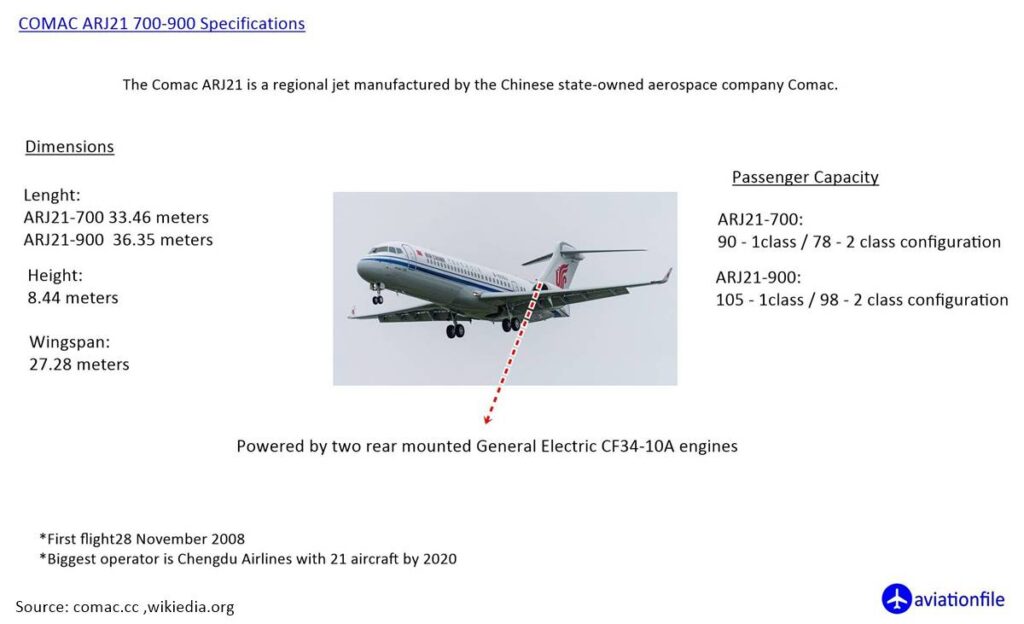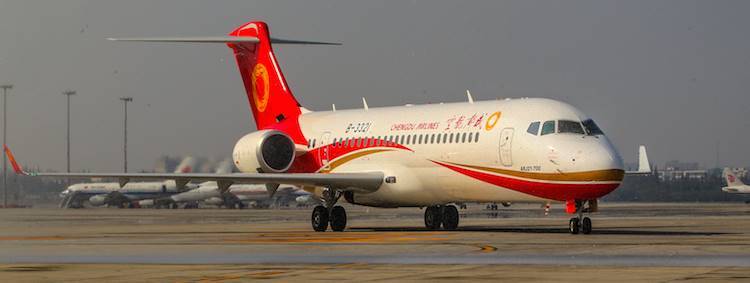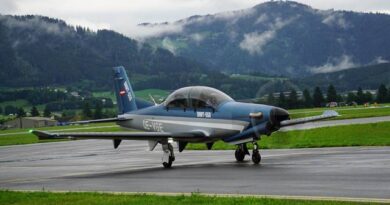The Comac ARJ21 – Twin-Engine Jet
The Comac ARJ21, also known as the Xiangfeng (“Soaring Phoenix”), is a twin-engine turbofan regional jet aircraft manufactured by the Commercial Aircraft Corporation of China (COMAC). Designed to compete in the short-haul regional market, the ARJ21 aspires to carve a niche for itself in the aviation industry.
A Look at the ARJ21’s Design and Performance:
- Passenger Capacity: The ARJ21 offers comfortable seating for 78 to 90 passengers in various configurations, catering to the demands of regional routes.
- Fuel Efficiency: Powered by General Electric CF34-10A engines, the ARJ21 boasts a maximum range of approximately 2,225 kilometers (1,383 miles), enabling efficient regional operations.
- Advanced Features: The aircraft incorporates a modern glass cockpit for enhanced pilot awareness and a supercritical wing design for improved fuel efficiency and performance.

Development and Market Entry:
- Program Launch: The ARJ21 program officially commenced in March 2002, marking a significant milestone in China’s aspirations for indigenous aircraft development.
- First Flight and Certification: The ARJ21 prototype took its maiden flight in November 2008, and after undergoing rigorous testing and certification processes, it received its airworthiness certificate from the Civil Aviation Administration of China (CAAC) in December 2014.
- Market Entry and Competition: The ARJ21 entered commercial service with Chengdu Airlines in June 2016. While primarily serving airlines within China, it faces established competitors like Embraer’s E-Jets and Bombardier’s CRJ series in the global regional jet market.
Despite its slow start, the ARJ21 has the potential to become a major player in the regional aircraft market. The aircraft is seen as a direct competitor to Embraer’s E-Jet series and Bombardier’s CRJ series, and is expected to benefit from the rapid growth of the Chinese aviation market. The Chinese government has also been actively promoting the ARJ21, with plans to use the aircraft in its “One Belt, One Road” initiative to boost economic ties with countries along the old Silk Road.
The ARJ21’s Significance and Future:
- A Stepping Stone: Despite utilizing foreign engines and avionics, the ARJ21 represents a crucial step for China’s commercial aviation industry, demonstrating their growing capabilities in aircraft design and manufacturing.
- Deliveries and Market Outlook: As of January 2024, over 125 ARJ21s have been delivered to airlines, primarily within China. While the aircraft faces stiff competition, COMAC continues to refine and promote the ARJ21, aiming to secure a stronger foothold in the regional jet market.
Additional Notes:
It is important to acknowledge that the ARJ21 program has faced challenges, including delays and technical hurdles during development. However, COMAC’s continued efforts to improve the aircraft and secure further orders suggest their commitment to the program’s long-term success.

Civil Aviation Administration of China (CAAC)
One of the main challenges facing the ARJ21 is its lack of international certification. The aircraft has only been certified by the Civil Aviation Administration of China (CAAC), which means that it cannot be flown to other countries without additional certification. Comac has been working to obtain certification from other aviation authorities, such as the Federal Aviation Administration (FAA) in the United States, but progress has been slow.
Another challenge for the ARJ21 is competition from established players in the regional aircraft market. Embraer and Bombardier have a strong presence in the market and have been actively developing their own next-generation regional aircraft. In addition, new players such as Mitsubishi Aircraft Corporation and Russia’s United Aircraft Corporation are also entering the market.
Overall, the Comac ARJ21 is an important development for the Chinese aviation industry. While it has faced significant challenges, the aircraft has the potential to become a major player in the regional aircraft market, particularly in China and other Asian markets. As Comac continues to develop the aircraft and work on obtaining international certification, the ARJ21 could become a symbol of China’s growing presence in the global aviation industry.


